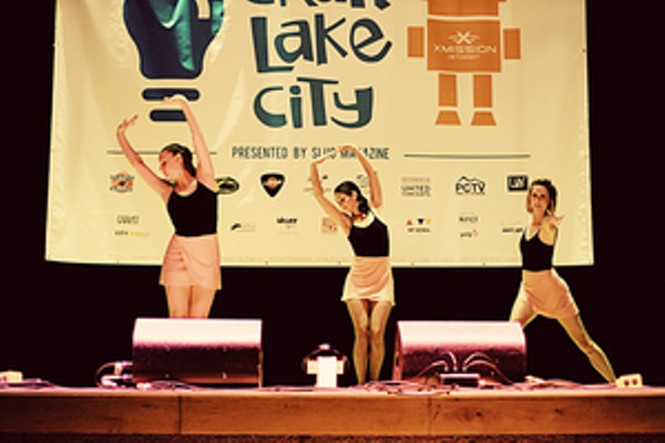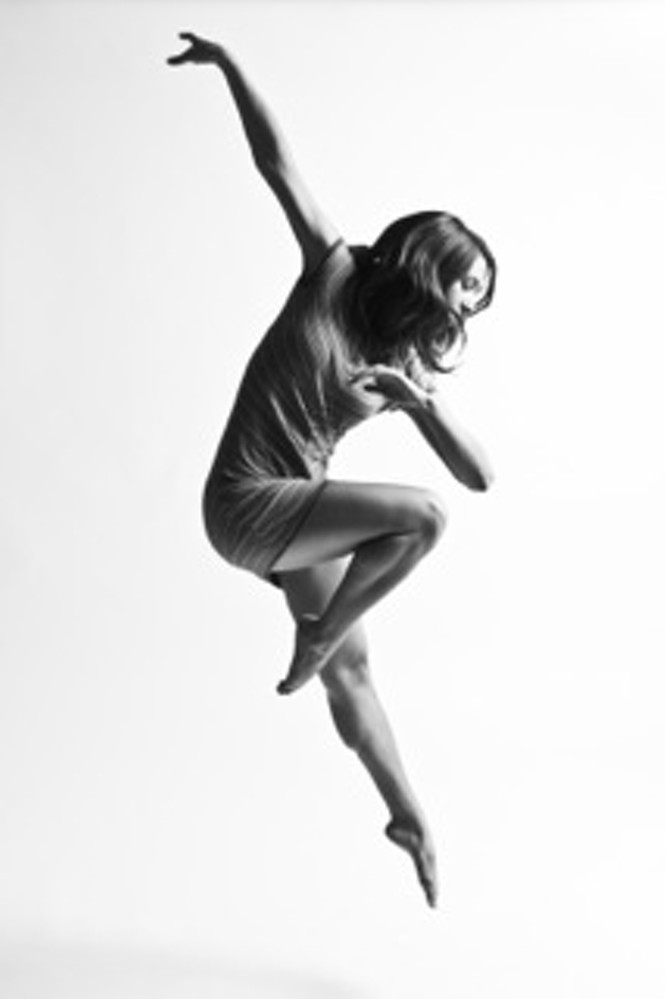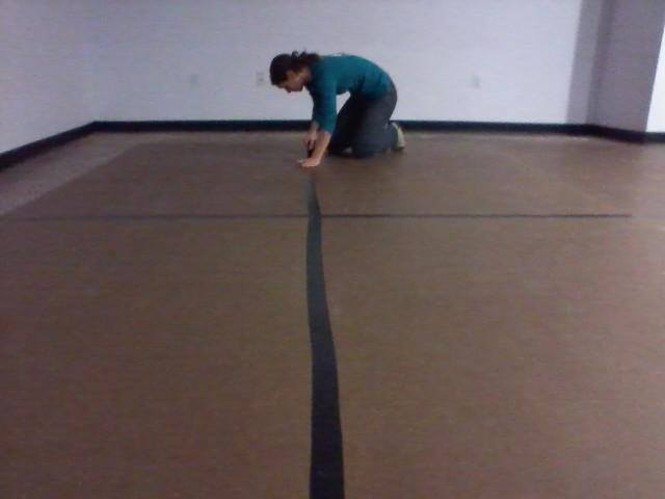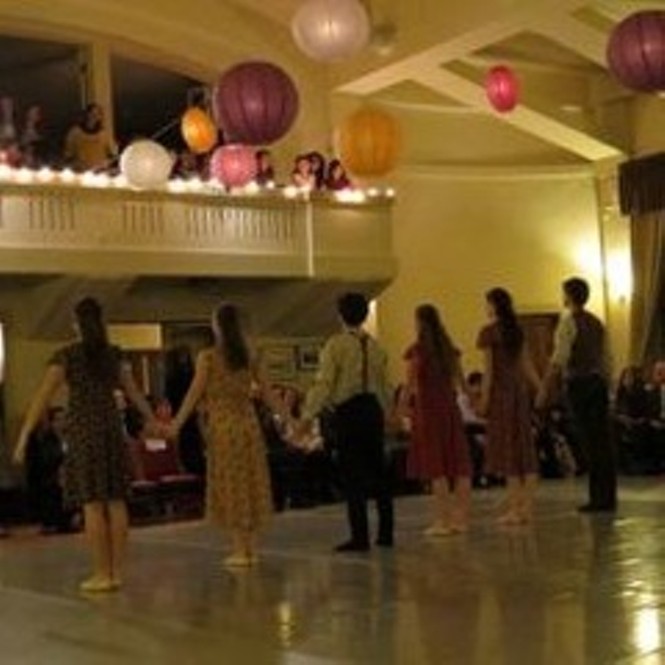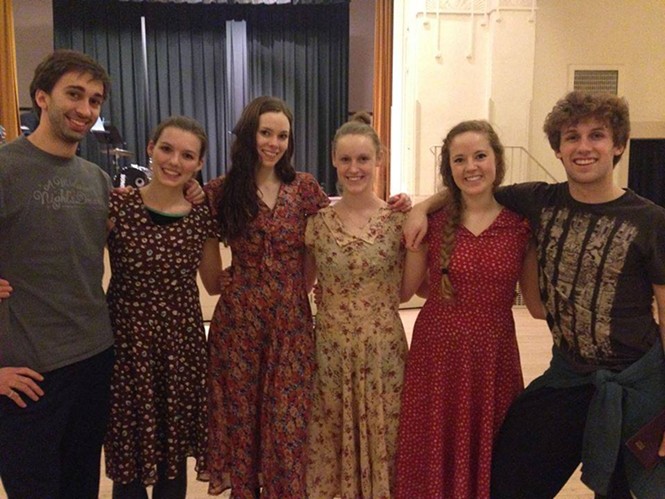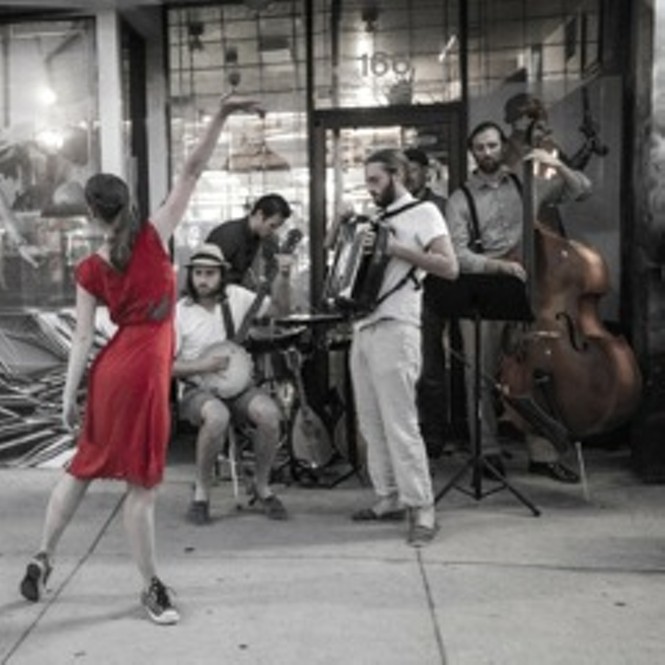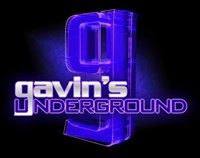Support the Free Press | Facts matter. Truth matters. Journalism matters
Salt Lake City Weekly has been Utah's source of independent news and in-depth journalism since 1984. Donate today to ensure the legacy continues.
Monday, December 15, 2014
Municipal Ballet Co.
Posted By Gavin Sheehan on December 15, 2014, 12:30 PM
Utah has its fair share of dance companies, both high-profile and independent, with various disciplines. But for the longest time, the only place you could find ballet-centric material were shows from Ballet West at the Capitol Theatre. But a short time ago, an independent organization called Municipal Ballet Co. formed, consisting of classically trained dancers and choreographers who have been providing the public with the same caliber of shows in a more contemporary environment. Today we chat with the founder of the company, Sarah Longoria, to talk about her career and forming the company into what it is today. (All pictures courtesy of the MBC.)
Municipal Ballet Co. on Facebook
Gavin: Hey Sarah,first thing, tell us a little bit about yourself.
Sarah: I was born and raised in California and received my undergraduate degree in ballet at the University of Utah. I moved back to California, married a native Utahn I had met in college [Editor's Note: City Weekly staff writer Colby Frazier] and had a daughter. I came back to Salt Lake for grad school and because we missed Utah. I am now a server at Desert Edge Brewery and I direct Municipal Ballet Co.
Gavin: What first got you interested in ballet and what was it like learning it at a young age?
Sarah: My parents tell me that I was 2 years old when I told them that I wanted to do ballet, so I don’t remember what made me say that. I’m guessing I must have seen a ballet performance on public television or something. They tried to put me in gymnastics, but I wouldn’t stand for it and only wanted ballet. I vividly remember my first dance class, at 3 years old, skipping and twirling around with a chiffon scarf. That was like heaven for me. It’s kind of crazy to me that I chose something at such a young age that I still really love.
Gavin: You started in California at the Santa Ynez Valley Performing Arts Company. What was your time like learning the craft and performing prior to college?
Sarah: I grew up in a small town, so from the ages of 5 through 17, I took ballet classes at the only studio within a 30-mile radius, from the same teacher all those years. I was lucky that she was great. She’s French and lovely to watch, and I always tried to mimic her movements exactly. After that, I took a year off after high school and before going to college to dance with the Santa Barbara Festival Ballet, mostly so I could fulfill my childhood dream of being a snowflake in their production of The Nutcracker. They’ve always had a live orchestra for their performance, and it’s in a lovely theater that looks like you’re outside, in the courtyard of a Spanish village, with stars on the ceiling of it. I learned a lot from the instructors in Santa Barbara. They really pushed me to be more daring and become a stronger dancer. The only quintuple pirouette en pointe I’ve ever done in my life was during class there, when I was 18. It was obviously mostly luck but wouldn’t have happened if my teacher at the time hadn’t pushed me to go for it.
Gavin: What eventually made you decide to attend the University of Utah for their program and what was it like earning your degree here?
Sarah: I applied to a lot of schools my senior year of high school, and auditioned for their dance departments, and was accepted at most of them. But, then I decided to take that year to dance in Santa Barbara, and during that year I only applied to the University of Utah (and hadn’t applied there the year before). I knew they had a good ballet program—they’ve been consistently ranked in the top three programs in the nation. The University of Utah is unique, in that they don’t have a “dance” program, but have two totally separate departments for ballet and modern dance. That really appealed to me. I like to think it was fate, though. When I came to Salt Lake to audition, it felt really good here, and I knew it was the right place for me to be.
Gavin: At that time, what were your impressions of the local dance community and the work coming out of it?
Sarah: During my undergrad, I did a horrible job of paying attention to what was going on in my dance community. I think a lot of ballet dancers are still like that, actually. It’s because there really never was anything going on in ballet, except for what Ballet West was doing, and I’d go see their shows every once in a while. The piece that had the most impact on me from that time was “Ghost Dances” by Christopher Bruce. I still love that piece. The modern dancers were always the ones doing stuff in the community, but modern dance wasn’t what I loved. I mostly watched, and was inspired by what the ballet students were doing at the university. I feel like that era in the department produced a lot of good choreography. I was particularly drawn to the pieces that used the contemporary music of that day—Bjork, Elliott Smith, Badly Drawn Boy, The Pixies, etc. I love all different kinds of music, and somehow, ballet seems well suited for almost all of it.
Gavin: You were a part of the U's ballet department. What made you decide to become a part of their program?
Sarah: I actually received my Master’s of Fine Arts from the ballet department in 2013, so I’ve been out of it for a bit now. There are a lot of things that made me want to come back to study ballet in Utah. I think one of them was that I had a daughter. There was something about having a child that made me realize I needed to do something that I loved in my life. Also, I think being pregnant made me really appreciate my body. As much as I had criticized my body in my younger days, I realized that it’s the only one I’ll ever have, so I’d better take advantage of it while I can. I also just couldn’t stop thinking about ballet. I would listen to music in the car and imagine ballet in my head. I would read about ballet in The New York Times, and I dreamt about dancing a lot. I guess I just realized that it was the thing that I would always love, and thought I’d go to school to figure out what I should do with it.
Gavin: How did the idea come about to start your own ballet company?
Sarah: I don’t think that I ever really intended to start my own company. I’m not a very organized person, not a natural leader, and definitely not a business person. I think I just really wanted a company like this to exist. I imagined it existing and could picture the folks of Salt Lake really appreciating it, and so I did my best to make it happen. It’s kind of amazing, the things you can accomplish when you really want something to come true.
Gavin: What was the process like putting together the company, and what was your goal with making the company a “public utility” of sorts?
Sarah: I made the company and its first performance my thesis project for grad school. It’s a really good thing I did, because then I was forced to do it in order to graduate, no matter how tough it was, or how unsure I was about it. I learned so much during the process—I had to organize people’s schedules, get rehearsal space, write a grant for theater space, and try to get people to come to the show. I was lucky to have had access to a lot of resources as a graduate student. It’s a bit harder now, to gather those resources. My goal for the company was, and still is, to bring ballet to the people. Ballet is what I love, and I want to share it with the people who I know and care about, the people of Salt Lake City. Whenever I told people what I was studying, they would usually be surprised (that you could actually get a masters degree in Ballet) and they would try to find something to say about it. Usually, it was, “I saw The Nutcracker once,” or “That’s cool. I don’t know much about ballet.” I didn’t likethat people felt like they needed to know something about ballet in order to appreciate it. I feel like everyone might really love ballet if they are given the chance. I’ve always liked the idea of having ballet as a community-sponsored art as if it were a necessity. In communist Cuba, ballet is sponsored by the government, and therefore really affordable, and a national pastime. They love it and get excited during performances, like Americans do at sporting events. I guess I made Municipal Ballet Co. because I wanted it to be for the people of our municipality, created by people also from our community. Maybe some day I’ll try to impose a “ballet tax,” where every resident can give one dollar toward ballet, and get free performances all year round! Maybe that’ll be the goal.
Gavin: How did you go about deciding who to bring on as performers?
Sarah: I’ve worked primarily with dancers and choreographers who I met through grad school because I saw how talented they were, and felt like their work needed to be seen. All of Municipal Ballet’s current dancers are really different in body type, and in quality of movement. They all have strong classical technique, though, and have great musicality. Most importantly, they are really great at connecting with the audience, at looking them in the eye and showing them who they are. Sometimes, they just glow when they dance. And for the audience to have this real, glowing human dancing for them, with live, amazing music playing—that’s the kind of thing that makes me want to keep this company going. The choreographers I’ve chosen are the ones whose work makes me feel something when I watch it, and whom I trust will create something awesome when I throw random music and dancers at them. One of the best parts about the process, for me, is being surprised at what the choreographers have come up with for the shows. All of the people involved are also so easy-going and willing to try new things (like do ballet in sneakers on the sidewalks.) They are all really kind and non-judgmental, and are willing to put up with some of my hair-brained schemes. I think we have a lot of fun in the process and feel like it’s really worthwhile to work hard and makegreat ballet for people to enjoy.
Gavin: For those who may not know subtleties and differences, what separates you from Ballet West?
Sarah: I think the companies are really two different animals, although we have ballet technique in common. Ballet West is a really high-caliber classical ballet company, with probably more than 30 dancers who hail from all around the globe. They have their own costume shop and buy shoes for their dancers. They have beautiful brand-new studios, right next to the Capitol Theatre, where they perform. They have an academy for young dancers, and they perform mostly classical repertoire, just like every big ballet company does, with some new works as well. They have a pretty big budget and can pay their dancers a living wage. Municipal Ballet Co. has seven dancers and five choreographers, who are all from Utah, or now call Utah home. We are currently, temporarily rehearsing in a space at the Main Salt Lake City Public Library, on floors that I pieced together using supplies from Home Depot. We have only one full-length performance per year (as of now,) using live local music and original choreography, in different venues. We dance on the sidewalks during the summer months, during the gallery strolls. I usually manage to pay the dancers a bit from ticket sales, but they’ve often donated their wages back into the company’s costs.
Gavin: Do you create your own original works or do you choose select pieces that people aren't aware of?
Sarah: All of the pieces in our shows are original works by local choreographers. The choreographers are given a selection of recorded music by the band we’re working with, that they can choose from, and they can also choose whichever dancers they want to work with from our company. Sometimes they don’t have a preference, and so I will choose music and certain dancers for them, and then they go for it. It’s incredible to see what they come up with.
Gavin: What were some of your first performances like and how were they received by the public?
Sarah: Our very first performance as a company was a 15-minute gig at Craft Lake City in 2012. We did four different pieces, and it was so great. We got to dance outside in the warm summer breeze, in front of an unassuming, diverse audience, who seemed to really enjoy it. We got a lot of good feedback behind the scenes, too, from the sound technicians and other volunteers who, it seemed, were pleasantly surprised that watching ballet didn’t suck as much as they thought it was going to.
Gavin: What was it like working with St. Boheme to have live music behind your show?
Sarah: Man, it was so fun to work with those guys. They’re so talented. They each play five instruments, and sometimes two at once, and their music just makes me feel good. It was a fun collaboration. It was a first for both of us, and it went pretty smoothly. Our first rehearsal together was kind of rough because we were so used to dancing to the recordings of their music, that if they played a couple of extra measures, or if the instrumentation was different, it threw us all off. We figured it out, though. I wouldn’t say that they were “behind” the show, either. They were definitely as much a part of it as the dancing. I feel like the dancing made the music sound better, and the music made the dancing look better—a perfect pairing. This last summer it was really fun to perform with St. Bohéme during the gallery stroll street performances. We didn’t even rehearse with them before hand, but the shows went really seamlessly. The dancers even improvised (made up the movements as they went along) to a few of their songs, and that was awesome to watch.
Gavin: Are you looking to become a nonprofit or stable company with a permanent theater, or do you prefer being a wandering company that can perform anywhere?
Sarah: I haven’t really figured out the nonprofit thing yet. Sometimes I think, “What if people liked what we do so much, that the company could just support itself through ticket sales?” There’s really no such thing as a dance company that isn’t a nonprofit, though. And I can definitely see that there are benefits to being a non-profit. Right now, we’re lucky enough to have Craft Lake City as our nonprofit sponsor. They’ve made it possible for us to use the space at the library to rehearse. As for being stable, I’d love to have a permanent home for Municipal Ballet Co. to use for company classes and rehearsals (let me know if you hear of any abandoned warehouses that need some occupants), but I really want to keep using different venues for our performances. I feel like the venue is really a part of the overall show, and I like being able to give each show a totally different feel.
Gavin: What are you currently working on for 2015 and when can we expect to see you next?
Sarah: I am really excited about our next project. We’re collaborating with local band Holy Water Buffalo for a show called “Oh Yeah.” It will be at The State Room on March 6-7. I can’t wait to see how it’ll turn out. I think it’s going to be awesome. Until then, you can stop by the City Library to see us. We’re located in the former Night Flight Comics shop on the rotunda in Library Square, and our classes and rehearsals are open to the public. So, you can see behind the scenes, how we make ballet! I also hope to continue doing some street shows and festivals with St. Bohéme next summer.
Gavin: What do you hope to achieve with Municipal Ballet Co. both in local dance circles and the community at large?
Sarah: I’m going to have to say that Municipal Ballet Co. is mostly for our community at large, the people of Salt Lake City. I just hope that people will come to our shows and enjoy the music and the dancing. Sometimes, I’ll go to a concert or read something well written, or see a piece of art that makes me glad to be human, and I hope that’s what our performances will do for people. I hope they inspire people to use this short life to do something they love. On the back-end, though, I hope that there is some sort of positive consequence for dancers and the art of ballet itself. For ballet dancers, there are not a lot of options out there (especially if you weren’t born with the extreme bone structure that is associated with an ideal ballet body). I hope that Municipal Ballet Co. shows ballet dancers that there isn’t just one way to present ballet. It’s an art, just like any other. It doesn’t necessarily need to take place in a grand theater with chandeliers hanging from the ceiling, with the women wearing stiff tutus and the men in tights. That classical, historic ballet can be absolutely beautiful as well. But, take it all away, and you still have ballet. Municipal Ballet hopes to prove that you can do ballet in the streets, you can do it without ballet barres or mirrors, you can perform it in bars or historic buildings. You can even show people how it’s not always perfect—how you wear baggy clothes and sweat a lot in class, and you might not get the choreography at first, but you work to make it comfortable in your body. You can show that you’re human and that you have limitations but that there is this bit of magic inside of you that comes out when you dance.
Municipal Ballet Co. on Facebook
Gavin: Hey Sarah,
Sarah: I was born and raised in California and received my undergraduate degree in ballet at the University of Utah. I moved back to California, married a native Utahn I had met in college [Editor's Note: City Weekly staff writer Colby Frazier] and had a daughter. I came back to Salt Lake for grad school and because we missed Utah. I am now a server at Desert Edge Brewery and I direct Municipal Ballet Co.
Gavin: What first got you interested in ballet and what was it like learning it at a young age?
Sarah: My parents tell me that I was 2 years old when I told them that I wanted to do ballet, so I don’t remember what made me say that. I’m guessing I must have seen a ballet performance on public television or something. They tried to put me in gymnastics, but I wouldn’t stand for it and only wanted ballet. I vividly remember my first dance class, at 3 years old, skipping and twirling around with a chiffon scarf. That was like heaven for me. It’s kind of crazy to me that I chose something at such a young age that I still really love.
Gavin: You started in California at the Santa Ynez Valley Performing Arts Company. What was your time like learning the craft and performing prior to college?
Sarah: I grew up in a small town, so from the ages of 5 through 17, I took ballet classes at the only studio within a 30-mile radius, from the same teacher all those years. I was lucky that she was great. She’s French and lovely to watch, and I always tried to mimic her movements exactly. After that, I took a year off after high school and before going to college to dance with the Santa Barbara Festival Ballet, mostly so I could fulfill my childhood dream of being a snowflake in their production of The Nutcracker. They’ve always had a live orchestra for their performance, and it’s in a lovely theater that looks like you’re outside, in the courtyard of a Spanish village, with stars on the ceiling of it. I learned a lot from the instructors in Santa Barbara. They really pushed me to be more daring and become a stronger dancer. The only quintuple pirouette en pointe I’ve ever done in my life was during class there, when I was 18. It was obviously mostly luck but wouldn’t have happened if my teacher at the time hadn’t pushed me to go for it.
Gavin: What eventually made you decide to attend the University of Utah for their program and what was it like earning your degree here?
Sarah: I applied to a lot of schools my senior year of high school, and auditioned for their dance departments, and was accepted at most of them. But, then I decided to take that year to dance in Santa Barbara, and during that year I only applied to the University of Utah (and hadn’t applied there the year before). I knew they had a good ballet program—they’ve been consistently ranked in the top three programs in the nation. The University of Utah is unique, in that they don’t have a “dance” program, but have two totally separate departments for ballet and modern dance. That really appealed to me. I like to think it was fate, though. When I came to Salt Lake to audition, it felt really good here, and I knew it was the right place for me to be.
Gavin: At that time, what were your impressions of the local dance community and the work coming out of it?
Sarah: During my undergrad, I did a horrible job of paying attention to what was going on in my dance community. I think a lot of ballet dancers are still like that, actually. It’s because there really never was anything going on in ballet, except for what Ballet West was doing, and I’d go see their shows every once in a while. The piece that had the most impact on me from that time was “Ghost Dances” by Christopher Bruce. I still love that piece. The modern dancers were always the ones doing stuff in the community, but modern dance wasn’t what I loved. I mostly watched, and was inspired by what the ballet students were doing at the university. I feel like that era in the department produced a lot of good choreography. I was particularly drawn to the pieces that used the contemporary music of that day—Bjork, Elliott Smith, Badly Drawn Boy, The Pixies, etc. I love all different kinds of music, and somehow, ballet seems well suited for almost all of it.
Gavin: You were a part of the U's ballet department. What made you decide to become a part of their program?
Sarah: I actually received my Master’s of Fine Arts from the ballet department in 2013, so I’ve been out of it for a bit now. There are a lot of things that made me want to come back to study ballet in Utah. I think one of them was that I had a daughter. There was something about having a child that made me realize I needed to do something that I loved in my life. Also, I think being pregnant made me really appreciate my body. As much as I had criticized my body in my younger days, I realized that it’s the only one I’ll ever have, so I’d better take advantage of it while I can. I also just couldn’t stop thinking about ballet. I would listen to music in the car and imagine ballet in my head. I would read about ballet in The New York Times, and I dreamt about dancing a lot. I guess I just realized that it was the thing that I would always love, and thought I’d go to school to figure out what I should do with it.
Gavin: How did the idea come about to start your own ballet company?
Sarah: I don’t think that I ever really intended to start my own company. I’m not a very organized person, not a natural leader, and definitely not a business person. I think I just really wanted a company like this to exist. I imagined it existing and could picture the folks of Salt Lake really appreciating it, and so I did my best to make it happen. It’s kind of amazing, the things you can accomplish when you really want something to come true.
Gavin: What was the process like putting together the company, and what was your goal with making the company a “public utility” of sorts?
Sarah: I made the company and its first performance my thesis project for grad school. It’s a really good thing I did, because then I was forced to do it in order to graduate, no matter how tough it was, or how unsure I was about it. I learned so much during the process—I had to organize people’s schedules, get rehearsal space, write a grant for theater space, and try to get people to come to the show. I was lucky to have had access to a lot of resources as a graduate student. It’s a bit harder now, to gather those resources. My goal for the company was, and still is, to bring ballet to the people. Ballet is what I love, and I want to share it with the people who I know and care about, the people of Salt Lake City. Whenever I told people what I was studying, they would usually be surprised (that you could actually get a masters degree in Ballet) and they would try to find something to say about it. Usually, it was, “I saw The Nutcracker once,” or “That’s cool. I don’t know much about ballet.” I didn’t like
Gavin: How did you go about deciding who to bring on as performers?
Sarah: I’ve worked primarily with dancers and choreographers who I met through grad school because I saw how talented they were, and felt like their work needed to be seen. All of Municipal Ballet’s current dancers are really different in body type, and in quality of movement. They all have strong classical technique, though, and have great musicality. Most importantly, they are really great at connecting with the audience, at looking them in the eye and showing them who they are. Sometimes, they just glow when they dance. And for the audience to have this real, glowing human dancing for them, with live, amazing music playing—that’s the kind of thing that makes me want to keep this company going. The choreographers I’ve chosen are the ones whose work makes me feel something when I watch it, and whom I trust will create something awesome when I throw random music and dancers at them. One of the best parts about the process, for me, is being surprised at what the choreographers have come up with for the shows. All of the people involved are also so easy-going and willing to try new things (like do ballet in sneakers on the sidewalks.) They are all really kind and non-judgmental, and are willing to put up with some of my hair-brained schemes. I think we have a lot of fun in the process and feel like it’s really worthwhile to work hard and make
Gavin: For those who may not know subtleties and differences, what separates you from Ballet West?
Sarah: I think the companies are really two different animals, although we have ballet technique in common. Ballet West is a really high-caliber classical ballet company, with probably more than 30 dancers who hail from all around the globe. They have their own costume shop and buy shoes for their dancers. They have beautiful brand-new studios, right next to the Capitol Theatre, where they perform. They have an academy for young dancers, and they perform mostly classical repertoire, just like every big ballet company does, with some new works as well. They have a pretty big budget and can pay their dancers a living wage. Municipal Ballet Co. has seven dancers and five choreographers, who are all from Utah, or now call Utah home. We are currently, temporarily rehearsing in a space at the Main Salt Lake City Public Library, on floors that I pieced together using supplies from Home Depot. We have only one full-length performance per year (as of now,) using live local music and original choreography, in different venues. We dance on the sidewalks during the summer months, during the gallery strolls. I usually manage to pay the dancers a bit from ticket sales, but they’ve often donated their wages back into the company’s costs.
Gavin: Do you create your own original works or do you choose select pieces that people aren't aware of?
Sarah: All of the pieces in our shows are original works by local choreographers. The choreographers are given a selection of recorded music by the band we’re working with, that they can choose from, and they can also choose whichever dancers they want to work with from our company. Sometimes they don’t have a preference, and so I will choose music and certain dancers for them, and then they go for it. It’s incredible to see what they come up with.
Gavin: What were some of your first performances like and how were they received by the public?
Sarah: Our very first performance as a company was a 15-minute gig at Craft Lake City in 2012. We did four different pieces, and it was so great. We got to dance outside in the warm summer breeze, in front of an unassuming, diverse audience, who seemed to really enjoy it. We got a lot of good feedback behind the scenes, too, from the sound technicians and other volunteers who, it seemed, were pleasantly surprised that watching ballet didn’t suck as much as they thought it was going to.
Gavin: What was it like working with St. Boheme to have live music behind your show?
Sarah: Man, it was so fun to work with those guys. They’re so talented. They each play five instruments, and sometimes two at once, and their music just makes me feel good. It was a fun collaboration. It was a first for both of us, and it went pretty smoothly. Our first rehearsal together was kind of rough because we were so used to dancing to the recordings of their music, that if they played a couple of extra measures, or if the instrumentation was different, it threw us all off. We figured it out, though. I wouldn’t say that they were “behind” the show, either. They were definitely as much a part of it as the dancing. I feel like the dancing made the music sound better, and the music made the dancing look better—a perfect pairing. This last summer it was really fun to perform with St. Bohéme during the gallery stroll street performances. We didn’t even rehearse with them before hand, but the shows went really seamlessly. The dancers even improvised (made up the movements as they went along) to a few of their songs, and that was awesome to watch.
Gavin: Are you looking to become a nonprofit or stable company with a permanent theater, or do you prefer being a wandering company that can perform anywhere?
Sarah: I haven’t really figured out the nonprofit thing yet. Sometimes I think, “What if people liked what we do so much, that the company could just support itself through ticket sales?” There’s really no such thing as a dance company that isn’t a nonprofit, though. And I can definitely see that there are benefits to being a non-profit. Right now, we’re lucky enough to have Craft Lake City as our nonprofit sponsor. They’ve made it possible for us to use the space at the library to rehearse. As for being stable, I’d love to have a permanent home for Municipal Ballet Co. to use for company classes and rehearsals (let me know if you hear of any abandoned warehouses that need some occupants), but I really want to keep using different venues for our performances. I feel like the venue is really a part of the overall show, and I like being able to give each show a totally different feel.
Gavin: What are you currently working on for 2015 and when can we expect to see you next?
Sarah: I am really excited about our next project. We’re collaborating with local band Holy Water Buffalo for a show called “Oh Yeah.” It will be at The State Room on March 6-7. I can’t wait to see how it’ll turn out. I think it’s going to be awesome. Until then, you can stop by the City Library to see us. We’re located in the former Night Flight Comics shop on the rotunda in Library Square, and our classes and rehearsals are open to the public. So, you can see behind the scenes, how we make ballet! I also hope to continue doing some street shows and festivals with St. Bohéme next summer.
Gavin: What do you hope to achieve with Municipal Ballet Co. both in local dance circles and the community at large?
Sarah: I’m going to have to say that Municipal Ballet Co. is mostly for our community at large, the people of Salt Lake City. I just hope that people will come to our shows and enjoy the music and the dancing. Sometimes, I’ll go to a concert or read something well written, or see a piece of art that makes me glad to be human, and I hope that’s what our performances will do for people. I hope they inspire people to use this short life to do something they love. On the back-end, though, I hope that there is some sort of positive consequence for dancers and the art of ballet itself. For ballet dancers, there are not a lot of options out there (especially if you weren’t born with the extreme bone structure that is associated with an ideal ballet body). I hope that Municipal Ballet Co. shows ballet dancers that there isn’t just one way to present ballet. It’s an art, just like any other. It doesn’t necessarily need to take place in a grand theater with chandeliers hanging from the ceiling, with the women wearing stiff tutus and the men in tights. That classical, historic ballet can be absolutely beautiful as well. But, take it all away, and you still have ballet. Municipal Ballet hopes to prove that you can do ballet in the streets, you can do it without ballet barres or mirrors, you can perform it in bars or historic buildings. You can even show people how it’s not always perfect—how you wear baggy clothes and sweat a lot in class, and you might not get the choreography at first, but you work to make it comfortable in your body. You can show that you’re human and that you have limitations but that there is this bit of magic inside of you that comes out when you dance.
On Topic...
-
Film Reviews: New Releases for April 19
The Ministry of Ungentlemanly Warfare, Abigail, The Beast, Hard Miles, Sasquatch Sunset and more
- Apr 19, 2024
-
Film Reviews: New Releases for April 12
Civil War, Escape from Germany, Coup de Chance, Hundreds of Beavers, La Chimera, Sting
- Apr 11, 2024
-
Film Reviews: New Releases for April 5
Monkey Man, The First Omen, Wicked Little Letters, Girls State, Scoop, Exhuma
- Apr 4, 2024
- More Gavin's Underground » More Culture »
More by Gavin Sheehan
-
Gavin's Underground: End Of An Era
Nine and a half years of local entertainment blogging comes to an end.
- May 26, 2017
-
Torris Fairley
A quick interview with the up-and-coming SLC-based comedian.
- May 25, 2017
-
Cirque Asylum
A look into the dance school teaching unique forms of aerial arts.
- May 24, 2017
- More »






